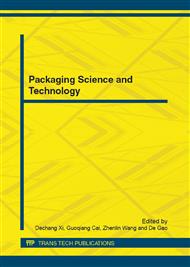p.147
p.151
p.155
p.160
p.167
p.171
p.175
p.180
p.186
Study on the Application of Puffing Glutinous Rice Starch
Abstract:
The puffing glutinous rice starch (PGRS) could be obtained by adding glutinous broken rice into bulking machine and expanding at a certain temperature and pressure. Compared with gelatinization by heating and adding alkali, gelatinization by puffing was easier to control and had a higher degree of starch gelation. The starch granule disintegrated after puffing and therefore more hydrophilic hydroxyls were exposed. The water-solubility of PGRS was increased which was shown in IR spectrometry with a broad and strengthened peak of O-H stretching vibration. Scanning electron micrograph (SEM) found that the PGRS granules were in shape of rough surface, which would be a strong affinity for water. Therefore, it could be used to prepare corrugated cardboard case adhesive, stamp envelope adhesive, wallpaper adhesive and dry mortar internal wall paint.
Info:
Periodical:
Pages:
167-170
Citation:
Online since:
October 2012
Authors:
Price:
Сopyright:
© 2012 Trans Tech Publications Ltd. All Rights Reserved
Share:
Citation:


